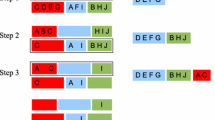Abstract
The Maximum Parsimony problem aims at reconstructing a phylogenetic tree from DNA, RNA or protein sequences while minimizing the number of evolutionary changes. Much work has been devoted by the research community to solve this NP-complete problem and many algorithms and techniques have been devised in order to find high quality solutions with reasonable computational resources. In this paper we present a memetic algorithm (implemented in the software Hydra) which is based on an integration of an effective local search operator with a specific topological tree crossover operator. We report computational results of Hydra on a set of 12 benchmark instances from the literature and demonstrate its effectiveness with respect to one of the most powerful software (TNT). We also study the behavior of the algorithm with respect to some fundamental ingredients.
Preview
Unable to display preview. Download preview PDF.
Similar content being viewed by others
References
Andreatta, A.A., Ribeiro, C.C.: Heuristics for the phylogeny problem. Journal of Heuristics 8, 429–447 (2002)
Cavalli-Sforza, L.L., Edwards, A.W.F.: Phylogenetic analysis: models and estimation procedures. Evolution 32, 550–570 (1967)
Edwards, A.W.F., Cavalli-Sforza, L.L.: The reconstruction of evolution. Annals of Human Genetics 27, 105–106 (1963)
Felsenstein, J.: Evolutionary trees from dna sequences: a maximum likelihood approach. Journal of Molecular Evolution 17, 368–376 (1981)
Fitch, W.: Towards defining course of evolution: minimum change for a specified tree topology. Systematic Zoology 20, 406–416 (1971)
Fitch, W.M., Margoliash, E.: Construction of phylogenetic trees. Science 155(3760), 279–284 (1967)
Foulds, L.R., Graham, R.L.: The steiner problem in phylogeny is np-complete. Advances in Applied Mathematics 3, 43–49 (1982)
Gascuel, O.: On the optimization principle in phylogenetic analysis and the minimum evolution criterion. Biology and Evolution 17, 401–405 (2000)
Goëffon, A., Richer, J.M., Hao, J.K.: A distance-based information preservation tree crossover for the maximum parsimony problem. In: Runarsson, T.P., Beyer, H.-G., Burke, E.K., Merelo-Guervós, J.J., Whitley, L.D., Yao, X. (eds.) PPSN 2006. LNCS, vol. 4193, pp. 761–770. Springer, Heidelberg (2006)
Goëffon, A., Richer, J.M., Hao, J.K.: Progressive tree neighborhood applied to the maximum parsimony problem. IEEE/ACM Transactions on Computational Biology and Bioinformatics 5(1) (January-March 2008)
Goloboff, P.A., Farris, J.S., Nixon, K.: Tnt: Tree analysis using new technology (2003), http://www.cladistics.com/aboutTNT.html
Goloboff, P.A.: Character optimisation and calculation of tree lengths. Cladistics 9, 433–436 (1993)
Hillis, D.M., Moritz, C., Mable, B.K.: Molecular Systematics. Sinauer Associates, Inc. (1996)
Holland, J.H.: Adaptation in natural and artificial systems. The University of Michigan Press, Ann Arbor (1975)
Nixon, K.C.: The parsimony ratchet, a new method for rapid parsimony analysis. Cladistics 15, 407–414 (1999)
Ribeiro, C.C., Vianna, D.S.: A grasp/vnd heuristic for the phylogeny problem using a new neighborhood structure. International Transactions in Operational Research 12, 1–14 (2005)
Saitou, N., Nei, M.: The neighbor-joining method: a new method for reconstructing phylogenetic trees. Mol. Biol. Evol. 4, 406–425 (1987)
Sokal, R.R., Michener, C.D.: A statistical method for evaluating systematic relationships. University of Kansas Science Bulletin 38, 1409–1438 (1958)
Sokal, R.R., Sneath, P.H.A.: Principles of Numerical Taxonomy. W.H. Freeman, San Francisco (1963)
Swofford, D.L., Olsen, G.J.: Phylogeny Reconstruction. In: Hillis, D.M., Moritz, C. (eds.) Molecular Systematics, ch. 11, pp. 411–501 (1990)
Waterman, M.S., Smith, T.F.: On the similarity of dendograms. Journal of Theoretical Biology 73, 789–800 (1978)
Author information
Authors and Affiliations
Editor information
Editors and Affiliations
Rights and permissions
Copyright information
© 2009 Springer-Verlag Berlin Heidelberg
About this paper
Cite this paper
Richer, JM., Goëffon, A., Hao, JK. (2009). A Memetic Algorithm for Phylogenetic Reconstruction with Maximum Parsimony. In: Pizzuti, C., Ritchie, M.D., Giacobini, M. (eds) Evolutionary Computation, Machine Learning and Data Mining in Bioinformatics. EvoBIO 2009. Lecture Notes in Computer Science, vol 5483. Springer, Berlin, Heidelberg. https://doi.org/10.1007/978-3-642-01184-9_15
Download citation
DOI: https://doi.org/10.1007/978-3-642-01184-9_15
Publisher Name: Springer, Berlin, Heidelberg
Print ISBN: 978-3-642-01183-2
Online ISBN: 978-3-642-01184-9
eBook Packages: Computer ScienceComputer Science (R0)




